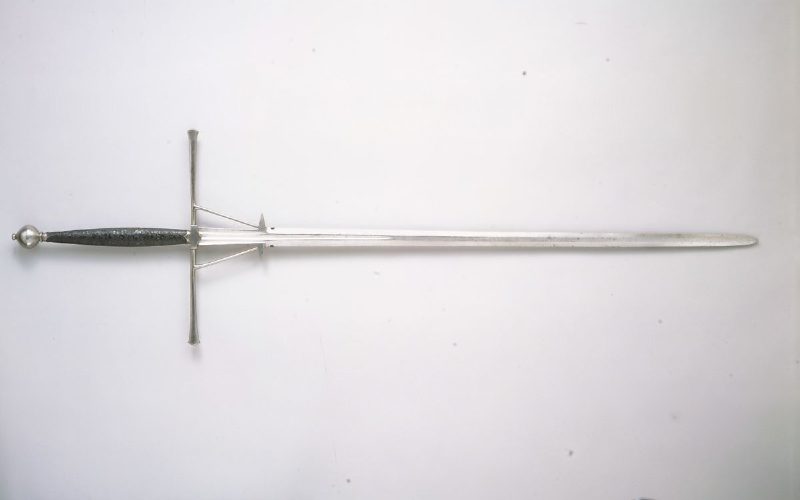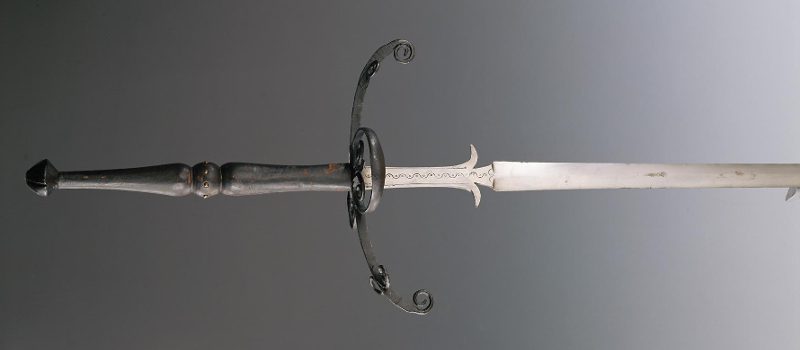Zweihander: A Guide to the German Two-Handed Swords

What’s in this article?
Two-handed swords were long favorite weapons in many parts of Europe. Recognized for its massive long blade with parrying hooks, the zweihander was the two-handed
This article discusses the history of the German two-handed
Characteristics of the Zweihander
For European weapons, two-handed swords often imply that the blades are usually far too long to be worn at the waist. Here are the unique characteristics of the German zweihander:
Metal and Construction
Throughout the Middle Ages and Renaissance, European swordsmiths were capable of producing high-quality steel blades that hold its edges. Given its massive size, zweihanders rarely had full tempered blades, though earlier swordsmiths likely forge-tempered them using excellent steel. Today, swordsmiths craft replicas from high carbon steel, but these tempered blades are often shorter than historical examples. Some are decorative swords with stainless steel blades.
Blade Appearance

The zweihander typically had a slender, slim blade with two parrying hooks. However, its blade shape, cutting edge, and ricasso may vary.
Blade Shape
Most German two-handers had straight blades, though there were also flammard blades with wavy, undulating edges. Straight blades were sometimes single-edged, but flammard blades were always double-edged with a sharp or blunted tip. Since the Landsknechts used the
Ricasso
The zweihander features a ricasso, an unsharpened part of the blade. It allowed the wielder to grip above the crossguard for greater strength. Historical examples had a thick ricasso, usually 1.5 centimeters with modern replicas often having the same thickness as the blade.
Parrying Hooks
Sometimes called parierhaken, parrying hooks served as a secondary guard for the ricasso to catch other weapons. They protrude from the blade, about 10 to 20 centimeters above the crossguard.
Size and Weight
The German two-handers have a massive length, ranging from 150 to 175 centimeters. They usually had a blade more than 120 centimeters long. Surprisingly, historical examples were not as heavy as they look. Fighting weapons were about 3 to 7 pounds, but ceremonial zweihanders were heavier and weighed about 10 to 15 pounds.
However, the blade length does not play a role in determining its weight as the blade cross-section and hilt style are other factors to consider. A zweihander with a slender blade measuring roughly 145 centimeters long may weigh just over 3 pounds. While the weapon required two hands, its long crossguard likely helped balance its weight.
Sword Mounting

German two-handers usually feature a crossguard that curves toward the blade and side rings on the quillons, though others are more elaborate. The pommel is often spherical or mushroom-shaped with a bare or leather-wrapped ricasso. The Landsknechts traditionally carried the
Facts About the Zweihänder Swords
During the Middle Ages, most infantry swords were lightweight and easy to wield, but by the late 15th century, heavier weapons like the zweihander became popular particularly in Germany. Here are some interesting facts about the German two-handed swords:
The term zweihander is a relatively modern name.
The German term zweihander literally means two-hander. Throughout history, the two-handed swords were called doppelhänder or double-hander, as well as bihänder or bidenhänder, which means both-hander. Other names include slaughter
The fiercest fighters who wielded the zweihander received double pay.
The Landsknechts who used the two-handed
Many collectors erroneously refer to the flame-bladed zweihander as flamberge.
Today, the French word flamberge has incorrectly become the accepted term to
The flammard blade of the zweihander did little to improve its cutting abilities.
There are several theories about flame-bladed types of swords in which the wavy blade would have inflicted a more deadly wound. However, experts conclude that the shape of the blade made little difference in its slashing abilities. The German two-handed
Unlike other longswords, the zweihander was not designed for actual fighting.
The German two-handers were used to strike down the opposing pikes and open gaps in the enemy’s formation. The doppelsöldner first created a breach, followed by comrades who fought the enemy’s force. There are no known historical records of the zweihander used in fencing. Yet, many surviving examples are often mistaken as actual combat weapons.
The zweihanders later served as ceremonial weapons.

In 16th- and early 17th-century Germany, the zweihanders became longer, heavier, more ornate, and served as parade swords, commonly referred to as paratschwert. Also called bearing swords, these weapons weighed about 10 to 15 lbs. The Swiss also used the two-handers during parades and ceremonial occasions.
The zweihander inspired several fictional weapons in role-playing games.
In the famous Elden Ring video game, the zweihander is the colossal
German Zweihander vs. Scottish Claymore

The Scottish Highlanders also had a two-handed
The zweihander often has a curving crossguard towards the blade and side rings on the quillons. On the other hand, the claymore has characteristic angled arms ending in quatrefoils. The Scots traditionally carried the claymore across the back. Comparatively, the Landsknechts carried the zweihander over their shoulders, similar to a halberd.
History of the Zweihänder Sword
During the 15th and 16th centuries, the German Landsknecht fought in numerous conflicts across Europe, armed with various weapons such as the zweihander, polearms, and crossbows.
Emperor Maximilian and the Landsknechts
In the battles of Morat and Nancy, the Swiss infantry won notable victories. Armed with long pikes, they attacked their enemies in tight phalanx formations. Lacking pike-wielding infantry and a regular army, German Emperor Maximilian I felt threatened by these military developments, so he hired the Landsknecht mercenaries in 1486 to fight for him when required.
The Landsknechts and the Zweihander
Most of the German Landsknechts were pikemen, but the doppelsöldners were experts in wielding the zweihander, smashing their way into enemy ranks. In the battle of La Bicocca in 1552, the German Landsknechts defeated the Swiss pikemen who were the elites of European battlefields for half a century.
The Decline of Zweihander Swords
By the close of the 16th century, European armies began to rely on gunpowder and abandoned pike formations in battles. It diminished the Landsknechts’ specialty in warfare, so the zweihander also disappeared from war. Still, it remained in the military arsenal as a ceremonial weapon.
Conclusion
The zweihander gained popularity in the 15th and 16th centuries when German Landsknecht mercenaries used the two-hander against enemy pike units. These warriors earned a fearsome reputation on the battlefield and their two-handed




